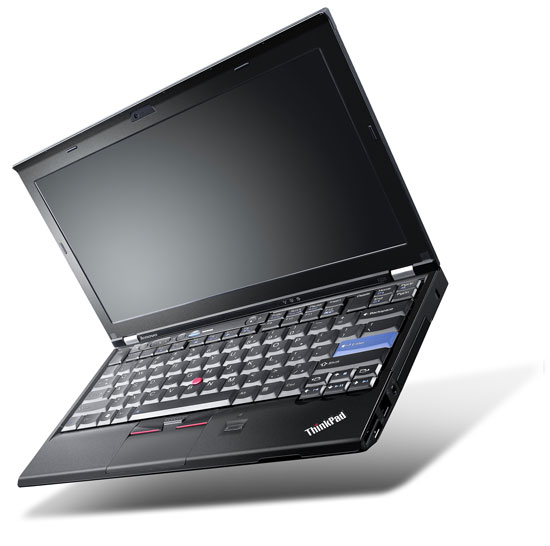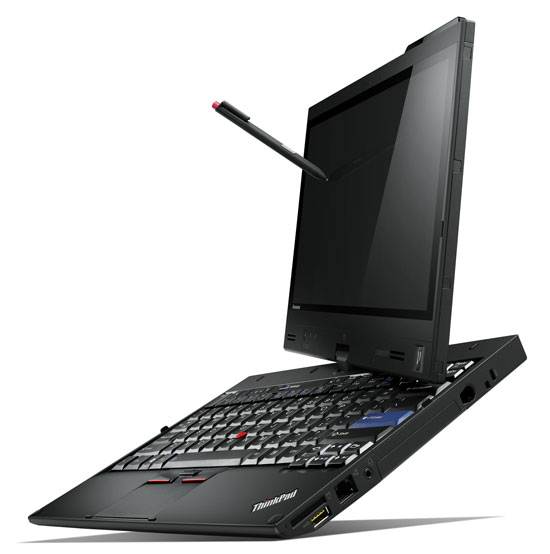Lenovo Announces ThinkPad X220 Series: 12" IPS with Sandy Bridge
by Dustin Sklavos on March 10, 2011 12:15 PM EST- Posted in
- IT Computing
- Intel
- Lenovo
- ThinkPad
- Sandy Bridge
- X220
- Laptops
We try not to bring you too much news about product announcements unless there's something particularly intriguing about them; we get inundated by them and most of the time it's the most generic of refreshes. Happily that's not the case with Lenovo's shiny new ThinkPad X220 notebooks.
Inexplicably Lenovo is opting to label these two very different notebooks under the same X220 header: one is a tablet clocking in at 3.88 pounds with a 4-cell battery; the other is an ultraportable that weighs less than three pounds. Both come with support for either SSDs or mechanical hard disks (with a 4GB SSD option as a special order).

We'll start with the ultraportable X220. Lenovo is shipping it with a 12.5" 1366x768 LED-backlit screen, but you can upgrade to an IPS panel. It maxes out at 8GB of DDR3 and has a strong spread of Sandy Bridge mobile processors to choose from, starting with the Core i3-2310M at 2.1GHz and going all the way up to the i7-2620M at 2.7GHz. Strangely, only the i7-equipped models come with USB 3.0 connectivity. Reviews of the X220 are already popping up on the internet and the IPS screen is proving as impressive as you'd expect, but not nearly as impressive as the battery running time: Lenovo claims up to 15 hours on a 9-cell battery, a hyperbolic figure to be sure but not as crazy as you'd think. NotebookReview's test model came with a 6-cell battery and was pushing nine hours.
You can see and eventually order the ultraportable X220 here, and MSRP is expected to start at a not-unseemly $899.

The other X220 is the tablet model. Again it ships with a 12.5" 1366x768 LED-backlit screen, but in this case the only choice is the finish you want on the IPS panel: Infinity Glass or Corning Gorilla. Yes, the X220 tablet comes with an IPS panel standard, proving that Lenovo understands what ViewSonic couldn't figure out with their tablet: that viewing angles are really important. Unfortunately the X220 tablet is nearly a pound heavier than its ultraportable cousin and doesn't come with an option for USB 3.0 connectivity. Lenovo quotes nine hours of running time with the 8-cell battery.
The X220 Tablet isn't up on Lenovo's site yet, but MSRP is expected to start at $1,199.










67 Comments
View All Comments
ImSpartacus - Thursday, March 10, 2011 - link
Anybody else hate the 1366x768 on the 12.5" screen? The 12.1" X200s had a 1440x900 screen, so don't tell me the screen is too small for all those pixels.I understand that they have to go to 16:9 eventually, but couldn't they just jump straight to 1600x900 so we wouldn't have any vertical resolution hardships?
Besides, comparing 1600x900 and 1440x900 makes 16:9 seem better. If you have to persuade rabid business professionals about an aspect ratio change, wouldn't that be a decent argument to use?
crimson117 - Thursday, March 10, 2011 - link
The lack of vertical resolution is very bothersome - most business class laptops start at 1280x800 or 1366x768. It's very cramped, especially with MS Office Ribbon-enabled programs, or programming/photoshop apps with large toolbars.martajd - Thursday, March 10, 2011 - link
Is it possible to orient the screen in portrait mode? That way you could gain necessary vertical resolution when there are thick toolbars.AnnihilatorX - Sunday, March 13, 2011 - link
Definitely. Any graphic driver allows rotation. Whether it's easy to use is another matter, without easy access to keyboardDrag0nFire - Thursday, March 10, 2011 - link
Just don't forget. It's cheaper to make our laptops look like our tv's. Why would anyone possibly want a laptop that doesn't look like a tv anyways? [/sarcasm]8steve8 - Thursday, March 10, 2011 - link
why must they go 16:9 eventually? Sure the market is pointing that way and all, panel availability and price must be favoring 16:9, but at some point a company should realize that for everything other than full-screen movie watching, wider is worse, and a big company or two could set up the supply for a panel with a better aspect ratio.and who's buying a 12" notebook for a cinematic experience?
its too bad lenovo is still wasting space on a standard 2.5" hdd, when they could put extra battery in that space like apple did with the new air. especially when intel's micro solid state drive is already an option on this thinkpad. At least use a 1.8" hdd if they must.
because of the 16:9 screen, and the wasted volume on a 2.5" slot, I'm waiting a couple months for the sandy bridge refresh of the 13" macbook air (which will hopefully still not be 16:9), even though i vastly prefer the trackpoint as a pointing device.
martajd - Thursday, March 10, 2011 - link
So it being slightly thinner is a reason to pay significantly more?Does not compute.
Although moving to 16:9 truly is a poor decision for productivity and/or anything but watching movies.
8steve8 - Thursday, March 10, 2011 - link
is it significantly more? remember that the x201s which uses low voltage processors (like the air does) cost more than the air.ive owned and used the x40, x41, x61, x201...
they are getting more bulky, and heavier.. the weight they quote is always with a 4-cell battery, while the battery life they quote is with 9+ cell.
my x40 with 12.1" screen is a better form factor then the modern x series... it had a 1.8" hdd, almost no screen bezel, and a non-widescreen aspect ratio.
they are making design choices to appeal to the mass audience, 2.5" hdds for consumers who want 320GB of storage cheap, and 16.9" screens.
clearly this is the time and the platform to commit to SSDs, which dont need a 2.5" space, or even a 1.8" one... lenovo played it too safe, and as a result, this design is significantly bigger than it could have been.
wetwareinterface - Friday, March 11, 2011 - link
well as an owner of the x61 you shouldn't bitch about a 2.5" hard drive... they managed to squeeze a 2.5" hard drive in that series and it was just as small as the x40 albeit a bit heavier. besides as an owner of an x40 you should realize that the 1.8" option is a complete sick joke. I loved waiting 2 minutes to boot into windows xp, and another 3 minutes for the drivers and helper apps to finally load so I could actually start waiting the 1 minute for my app to show up after launching it. yeah give me a 1.8" hard drive in a modern system with a sandy bridge so i can be taken back to floppy drive load times...the only problem with these systems that I can see is indeed the screen real estate being too small. however ips panels aren't that common and in this size they may be restrained in offering the pixel depth they want to. still the most impressive laptop announcement this year in small computing is the ips as standard touch screen x220 for $1199. as it has a standard 2.5" hard drive bay you can slap whatever you want in there aftermarket, intel ssd, velociraptor, 500GB green etc... pick your poison.
DanNeely - Thursday, March 10, 2011 - link
1.8" HDDs are slower than the 2.5" variety.The reason they "have" to go to 16:9 is that while they could specifiy a 16:10 (or even a 4:3) screen if they wanted, the production volume is no longer there because all the mass market devices are 16:9 which means the price would be significantly higher unless they are able to buy them in massive quantities (eg iPad), or are willing to charge a large price premium on the device.